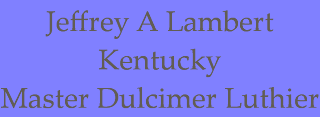



The dulcimer (which literally means "sweet music") has been called by many names, including the Appalachian dulcimer and lap dulcimer. The state of Kentucky has named the dulcimer as the state instrument. It is thought to be a true American folk instrument, originally made sometime in the mid-1800s. It was mostly regionalized to the Appalacia and Ozark regions until the mid-50s and today continues to grow in popularity with both amateur and professional musicians.
The Strings
Traditionally dulcimers have three strings; melody (the string closest to the player), the middle and the bass. The four stringed dulcimer (like my Dulcimers) is commonly arranged so that the melody string is doubled up and therefore is actually a variation of the three . The melody is generally played on the first two strings and the other two are considered "drone" strings.
Playing Position
Placing the instrument horizontally across a table or the player's lap, typically the musician's right hand strums the strings with fingers or pick. The left hand plays a melody line by pressing down on the fretboard with a (usually a rounded stick or twig) or fingers.
It is considered one of the easiest instruments to learn, many musicians playing simply by ear. If you can hum a song, more than likely you will soon be able to it on the dulcimer!
Tuning
The dulcimer is quite different from the guitar or banjo in that it has no set tuning. Rather it can be tuned a number of different ways. At first this may seem confusing but actually allows each musician the flexibilty of finding their own "voice" with their instrument. I set up the tuning on my Dulcimers to the traditional "D-A-A" tuning.
The Shape
The shape of a dulcimer can be quite varied with the most traditional shapes being a tear-drop, hour-glass, rectangle or diamond shape. The shape of the sound board does not really affect the instrument's sound but does reflect the region it was built in and the style of the craftsperson making it. My Dulcimers are made in a variety of shapes which I learned from my mentor, a master dulcimer builder (John Carl Ramey, Carter City, KY). John Carl believed the Traditional Style Dulcimer held to the spirit of made in hills of eastern Kentucky and southern West Virginia.
The Strings
Traditionally dulcimers have three strings; melody (the string closest to the player), the middle and the bass. The four stringed dulcimer (like my Dulcimers) is commonly arranged so that the melody string is doubled up and therefore is actually a variation of the three . The melody is generally played on the first two strings and the other two are considered "drone" strings.
Playing Position
Placing the instrument horizontally across a table or the player's lap, typically the musician's right hand strums the strings with fingers or pick. The left hand plays a melody line by pressing down on the fretboard with a (usually a rounded stick or twig) or fingers.
It is considered one of the easiest instruments to learn, many musicians playing simply by ear. If you can hum a song, more than likely you will soon be able to it on the dulcimer!
Tuning
The dulcimer is quite different from the guitar or banjo in that it has no set tuning. Rather it can be tuned a number of different ways. At first this may seem confusing but actually allows each musician the flexibilty of finding their own "voice" with their instrument. I set up the tuning on my Dulcimers to the traditional "D-A-A" tuning.
The Shape
The shape of a dulcimer can be quite varied with the most traditional shapes being a tear-drop, hour-glass, rectangle or diamond shape. The shape of the sound board does not really affect the instrument's sound but does reflect the region it was built in and the style of the craftsperson making it. My Dulcimers are made in a variety of shapes which I learned from my mentor, a master dulcimer builder (John Carl Ramey, Carter City, KY). John Carl believed the Traditional Style Dulcimer held to the spirit of made in hills of eastern Kentucky and southern West Virginia.




